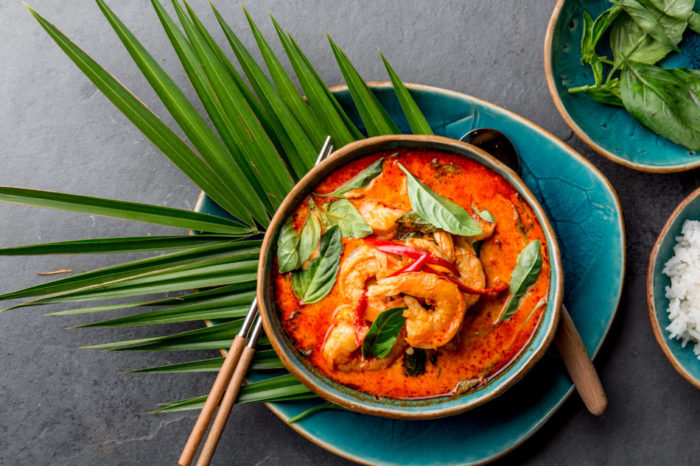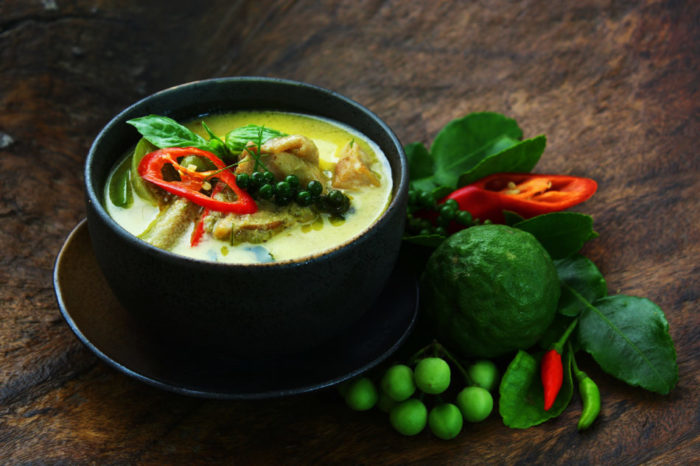The wonderful Thai cuisine makes generous use of curry (or curry pastes) for food flavoring and taste. If we pit two of the famous options together, we can think of an excellent comparison in red curry vs green curry. As we can very well guess, the difference is more than just color!
Both these dishes offer flavoring, consistency, and some moisture to the food. Often, they’ll also add heat and the curries can indeed be pretty spicy.
If the hotness and spiciness of the curries is your main consideration, keep in mind that red curry is usually hotter and spicier than green curry. However, there are more differences, specifically about taste that need to be considered as well.
Let’s take a look at these curries individually and as a combination to see how it all lines up.
Green vs Red Curry Paste
It’s obvious to make comparisons and draw parallels between green and red curry paste. Both of similar consistency and find copious use in many recipes, especially with Thai cuisine. The obvious difference between both these curry pastes is the color. As is evident, the red curry has a red color, while the green curry is, well, green!
Appearances aside, they also differ in flavor and heat. Red curry is fairly hot and other flavors in this curry remain subdued. Green curry is relatively mild (though still hot) and also shows off other flavors in its recipe. Green curry has a very noticeable sweet tone that works beautifully with other flavors and ingredients.
What Is Red Curry?

Red curry, or red curry paste is a key ingredient in several recipes and Thai cuisine. As the name implies, the curry has a red color. Usually, this color comes from the use of several chilies. Often, it’s dry red chilies that go into this curry to form the paste, though conventional hot chilies aren’t off-limits either.
Some chefs skip grinding the chilies and instead use red chili powder to get the same effect. Of course, there’s more to the curry than just its hotness. Red curry also includes other spices and ingredients like coconut milk, garlic, shrimp paste, and more.
There can be variations in the taste and preparation, usually varying between regions. As an example, red curry from the north of Thailand is different from the south. Although there are smaller regional variations too.
In some cases, modern chefs will use chili powder to get a deeper color and a hotter flavor for their recipe. The traditional method is still popular too. In this case, cooks may choose almost twenty dried red chilies for a single serving and soak them in water overnight.
Soaking them helps retain or even improve the color of chilies. It also takes away some harshness from the chilies to make them more delicious and have the colors stand out.
What Is Green Curry?

Green curry or green curry paste is another popular ingredient in several Thai recipes. True to its name, the paste has a green color. Just as red curry gets its color from the use of red chilies, the green color here comes from the use of green chilies in the cooking process. Sometimes, basil and coriander might also play a part in maintaining the color of this curry.
As for hotness, green curry isn’t as hot as red curry. Don’t take it lightly though, green curry is pretty hot, just not as hot as its red sibling! Although green curry also makes a prominent showing of other flavors, including sweetness. The sweetness is a key difference between red and green curry, especially if you go beyond simply the color.
Green curry shares several ingredients with red curry, though there are some unique ingredients too. Some common ingredients for this curry are ginger, shallots, lemongrass, and kaffir lime leaves.
FAQs And More On Green And Red Curry Paste
Which Curry Is Hotter? Green Or Red?
Typically, red curry is the hotter curry, getting its heat from the large amount of red chili peppers used in its preparation. Although green curry is milder, it would be wrong to assume that it doesn’t have much heat. Depending on the chili used, green curry can get as hot as red curry. In some cases, cooks might tone down the heat of red curry, while allowing green curry to get hotter.
If you’re ordering at a restaurant, it’s best to ask how hot their curries are. Generally though, you can expect the red curry to be hotter.
Which Curry Is Least Hot And Spicy?
Thai cuisine generally uses three curries, red, green, and yellow. In most cases, red curry paste is the hottest and yellow curry paste is the mildest. Again, it’s worth noting that all these curry pastes contain a fair amount of chilis. It’s just that yellow happens to be the mildest, but is still contains a fair amount of chilis.
Enjoying Your Thai Curry Pastes
Red, green, and yellow curry pastes are important parts of Thai cuisine and make for great recipes that you can enjoy. The similarity between these dishes might make you wonder if there is a difference between them beyond the colors? Well, as it turns out, there is a difference.
While the curries have different levels of hot and spicy flavors, they also differ in underlying flavors and taste notes. In a red curry vs green curry comparison, it is important to know that red curry is usually the hotter one. Green curry often contains strong undertones of sweetness and shows off other flavors with more gusto.